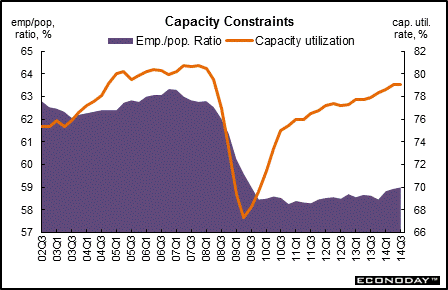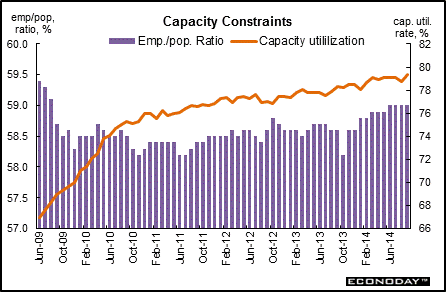
|
Long Term Perspective The Federal Reserve monitors capacity constraints because they indicate where supply bottlenecks are developing and inflation is beginning to simmer. The capacity utilization rate in the economy's industrial sector during the latest recession and early recovery was down sharply from the highs established in 1995 and again in 1997. The National Bureau of Economic Research (NBER) declared that the latest business cycle peak was December 2007. Yet, the capacity utilization rate was declining long before the recession began. This rate did rebound with the overall economic recovery. The employment-to-population ratio is more comprehensive than the jobless rate in revealing labor market conditions. This index peaked about two years before the most recent recession began at the end of 2007. The employment-to-population ratio declined from late 2006 through late 2009 and has since remained low.
Short Term Perspective The employment-to-population ratio turned back down in latter 2010 as the labor market saw more layoffs and a rise in the labor force. But from early 2011 and into early 2013, moderate employment growth bumped this rate up slightly. Likewise, the capacity utilization dropped sharply in 2008 and into mid-2009 as production declined during the past recession for both manufacturing and the overall industrial production. But with recovery in manufacturing, capacity utilization had been on an uptrend from mid-2009 through mid-2014. In September, the capacity utilization rate rose to 79.3 percent from 78.7 percent the month before.
|
|||||||
| Legal Notices | ©Copyright 1998-2025 Econoday, Inc. |
powered by
![[Econoday]](images/logo.gif)
![[Apple App Store]](/images/AppleAppStore.png) ![[Econoday on Kindle]](/images/kindle.jpg) 
|
||||||

